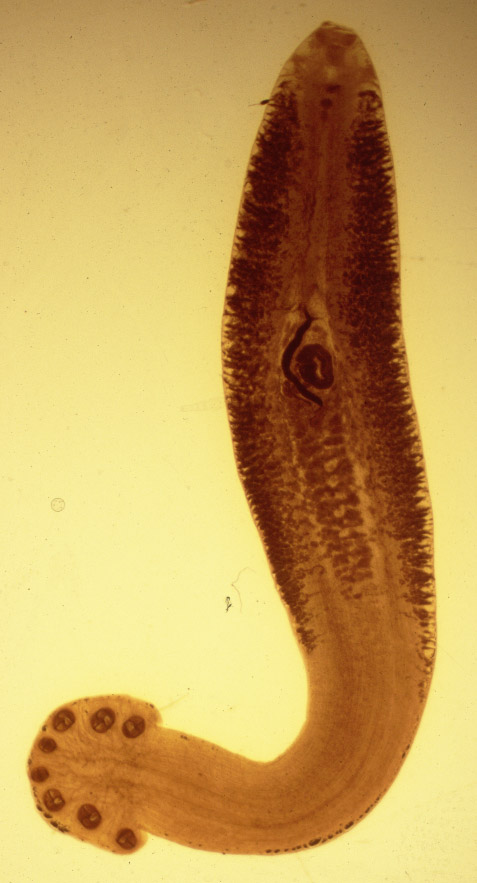

| Parasite | Heterobothrium okamotoi |
|---|---|
| Taxonomy | Plathyhelminthes, Monogenea, Polypisthocotylea |
| Host | Tiger puffer (Takifugu rubripes) |
| Infection site | Gill filament, branchial cavity wall |
| Clinical sign | The gills become pale and anaemic by blood-feeding of the parasite in heavy infection. |
| Parasitology | The parasite body is 7-24 mm
long and elongated. After the oncomiracidium (larva) attaches on the gill filament,
immature worm develops for one month, following to movement into the branchial
cavity wall for maturation. The parasite grasps the branchial cavity wall by a haptor
with 4 pairs of clamps at the posterior end. Both immature and mature parasites
feed on the host’s
blood. The hermaphroditic adult produces numerous eggs. The longest egg string
(eggs linked by the filament) is over 2.8 m (Ogawa, 1997). The strongest infectivity
of the hatched larvae is observed on < 1 day post-hatch. A few larvae can
infect on 4 days post-hatch (Chigasaki et
al., 2000). |
| Pathology | The gills become pale and anaemic, and the fish will
die in the heavy infection. No pathological changes
are detected when the parasite infect to the gill filament. However, extensive
inflammation is observed after the parasite migrates to the branchial cavity
wall. The posterior part of the parasite body is encapsulated by the
proliferated tissues of the host (Ogawa and Inouye, 1997). The lesion becomes
necrotic due to inflammation, immersion of the sea water and secondary
infection of bacteria. |
| Health hazard | Since this parasite is not infectious to human, it is harmless in food hygiene. |
| Diagnosis | Adults attaching the branchial cavity can be visually seen. Immature parasites attaching the gill filament can be observed under the light microscope. Identification is easy because no similar monogenean parasitizing tiger puffer is known. |
| Other information | Reinfections occur inside a net cage since the eggs with a long filament readily become entangled with the net meshing. Therefore, frequent changes of net cages are recommended. Currently, bath treatments with a hydrogen peroxide solution and oral administration of febantel (praziquantel) can be used to control the parasite. A hydrogen peroxide is effective only for the immature parasites attaching the gill filaments. It is recommended that both net cage changes and pharmacological treatments are performed in concert with neighboring farm. |
| References | Chigasaki, M., K.
Ogawa and H. Wakabayashi (2000): Standardized method for experimental infection
of tiger puffer, Takifugu rubripes
with oncomiracidia of Heterobothrium
okamotoi (Monogenea: Diclidophoridae) with some data on the oncomiracidial
biology. Fish Pathol., 35, 215-221. Ogawa, K. (1997): Copulation and egg production of the monogenean Heterobothrium okamotoi, a gill parasite of cultured tiger puffer (Takifugu rubripes). Fish Pathol., 32, 219-223. Ogawa, K. and K. Inouye (1997): Heterobothrium infection of cultured tiger puffer, Takifugu rubripes (Teleostei: Tetraodontidae) - a field study. Fish Pathol., 32, 15-20. |
Fig. 2. A stained specimen of H. okamotoi
(Photos by K. Ogawa)
Fig. 1. Anaemic gill of tiger puffer caused by H. okamotoi (arrows)
attaching on the branchial cavity wall.
